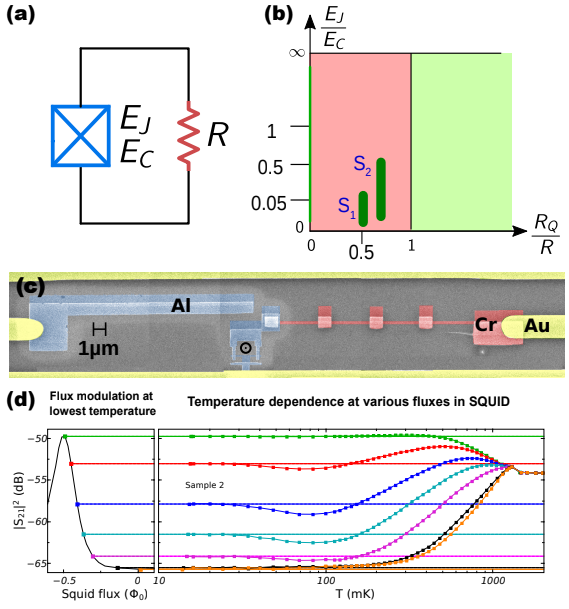


|
It has been theoretically predicted by Schmid in 1983 that any Josephson junction shunted by a large-value resistance R should not be superconducting, but insulating in its ground state. Some experiments initially confirmed this theory. In a new well-controlled experiment, a collaboration of physicists from SPEC and German universities show that it is not the case, and solves in that way the paradox that at the R infinite limit, no Josephson Junction should be superconducting ! |
In 1962 Josephson predicted that an electric current can flow with no applied voltage through a thin insulating layer separating two superconductors. Following the invention of this ”Josephson junction” (JJ), there flourished an array of practical quantum electronic devices with unique properties : squids magnetometers, parametric amplifiers, RSFQ logic circuits, superconducting qubits… Among these devices, the Josephson voltage standard notably helped rebasing the International System of Units on quantum effects in 2019. In the recent years, JJ-based quantum electronic devices have also been under the spotlight owing to the intense research and huge progress made towards making “quantum processors” that could perform some tasks that are out of reach of super-computers. All these great engineering feats testify that the JJ behavior is very well understood.
Yet, surprisingly, a recent article by a team of SPEC researchers and German theoreticians [1] shows that the interaction of a JJ with a resistive electromagnetic environment was misconceived and inconsistent so far.
Specifically, it was commonly believed that any Josephson junction shunted by a large-value resistance R should not be superconducting but insulating in its ground state, due to a dissipative quantum phase transition occurring at R=RQ=h/4e²≈6.5kΩ. The original prediction, made by Schmid in 1983, was amply confirmed theoretically and a handful of experiments performed in the 90's claimed to have verified the prediction. Schmid's original paper has received around 400 citations and its prediction was widely thought to be unquestionable.
Yet, in spite of this unanimity, that prediction of a dissipation-induced insulating state in JJ was unsettling because it induces a paradox in the limit R→∞. Indeed, in this limit, the resistance can be essentially removed from the circuit and we are back to Josephson's result: the JJ must be superconducting, in contradiction with Schmid's prediction. Strangely, no one seemed to bother about this rather trivial and long-standing theoretical inconsistency.
By performing well-controlled measurements of JJs connected to resistances larger than RQ, the SPEC physicists could show that the JJ linear response saturates at low temperature, unambiguously keeping a superconducting character (see Fig.1). These experimental findings exclude the existence of Schmid's phase transition in JJs.

Beyond this experimental conclusion, the authors explain that Schmid's prediction is actually valid only for normal-state systems but not for superconducting ones (and hence not the JJ, in particular). Indeed, although these two types of systems are described by similar effective 1D equations, a subtle difference in the topology (linear vs circular) of the coordinate that describe their coupling to the dissipative environment radically changes their physics.
The article hence resolves the theoretical inconsistency and provides a simple, unified, understanding of the interaction of JJs with their electrical environment. This work may open the way to new JJ-based high impedance superconducting devices, which were previously believed unfeasible because of the predicted phase transition.
Reference :
[1] Absence of a Dissipative Quantum Phase Transition in Josephson Junctions, A. Murani, N. Bourlet, H. le Sueur, F. Portier, C. Altimiras, D. Esteve, H. Grabert, J. Stockburger, J. Ankerhold, and P. Joyez, Phys. Rev. X 10, 021003 (2020)
Contact CEA : Philippe Joyez, Quantronics Group (SPEC/GQ)
Collaboration :
•  Électronique et optique du futur › Electronique quantique et technologies quantiques
Électronique et optique du futur › Electronique quantique et technologies quantiques
•  Institut Rayonnement Matière de Saclay • UMR 3680 - Service de Physique de l'Etat Condensé (SPEC)
Institut Rayonnement Matière de Saclay • UMR 3680 - Service de Physique de l'Etat Condensé (SPEC)
